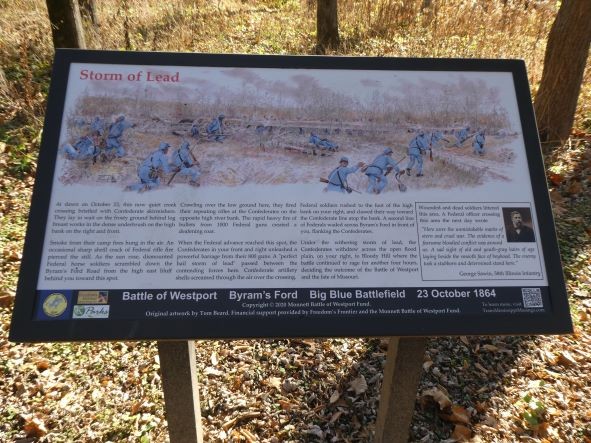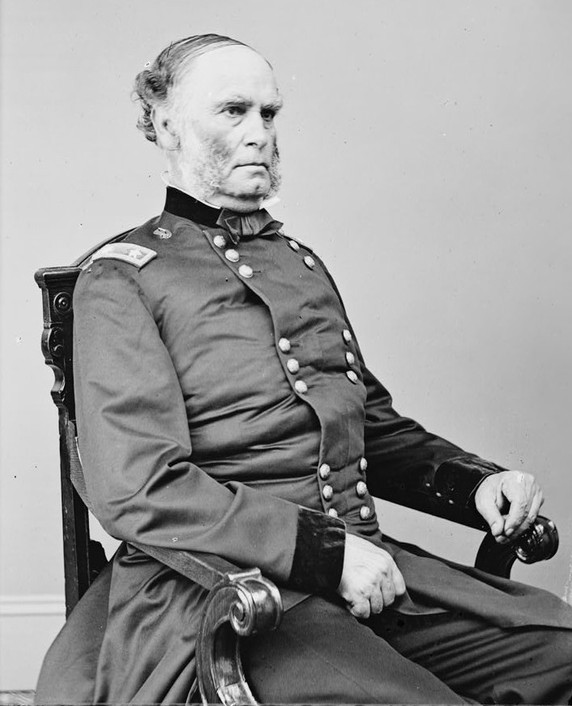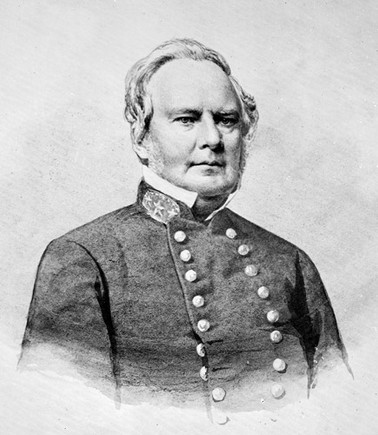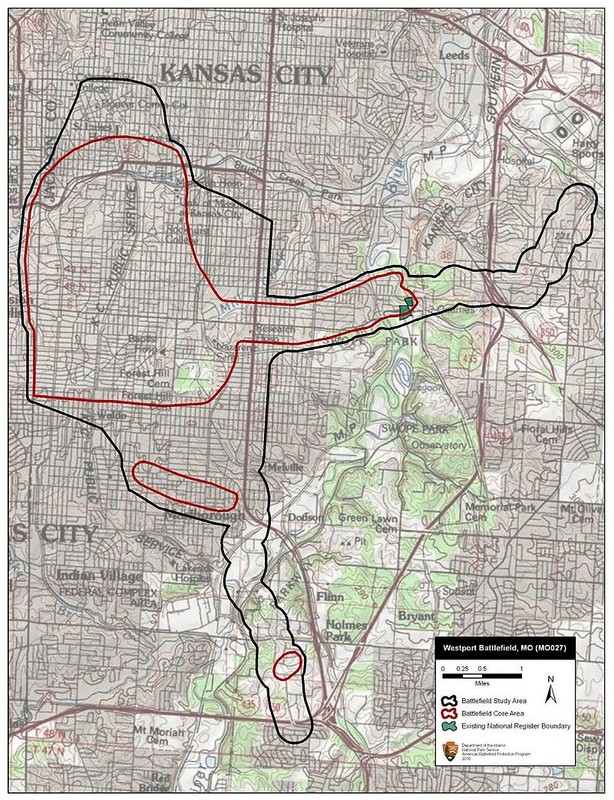Byram's Ford and Big Blue Battlefield Historical Marker Tour Stop 16 (Battle of Westport Driving Tour) (Price's Raid)
Introduction
Text-to-speech Audio
A crucial chapter in both the Second Battle of Independence (Oct. 22) and the Battle of Westport (Oct. 23), this historical marker shares the history of the two days of fighting at Byram's Ford, which is now part of Kansas City's Swope Park. The battle that occurred here was also a pivotal moment in Confederate General Sterling Price's cavalry raid through Missouri in 1864. Price first used the ford to move his men and slip away from Union General Samuel Curtis' formidable defenses, and the following day Union cavalry would smash through Price's rearguard and seal the trap that would annihilate his army in the ensuing week. The marker can be found by following the trail alongside Hardesty Avenue just a few hundred feet west.
Images
A photo of the historical marker by Robert Macroubie. This marker is located along the trail that can be accessed at Hardesty Avenue and other points within Swope Park.

General Samuel R. Curtis, whose misjudgment caused Byram's Ford to be only lightly defended. Confederates pushed across at the ford and avoided fighting against Curtis's defenses near Kansas City. Courtesy of Wilson's Creek Battlefield.

Confederate General Sterling Price, whose army narrowly escaped destruction on Oct. 22--but not for long. The battles of Westport and Mine Creek on Oct. 23 and 25 would dash his hopes of securing Missouri for the Confederacy.

The 1993 Study Area boundaries did not include the October 23rd action at Byram’s Ford. National Park Service survey of the battlefield. The long red area extending westward covers fighting during the Union retreat on the 22nd, after Price's army forced its way across Byram's Ford.

Backstory and Context
Text-to-speech Audio
Though they merit study as their own distinct episodes, the fights at Byram's Ford on October 22 and 23, 1864 are actually regarded as part of the larger battles of 2nd Independence and Westport, respectively. In the case of the former, Confederate General Sterling Price deftly sidestepped Union General Samuel Curtis's "Army of the Border," which lay firmly entrenched on the western banks of the Big Blue River, daring Price to attack Kansas City. The following day, Union cavalry under General Alfred Pleasonton, which had been operating in Price's wake for several days, caught up with his 12,000-man Army of Missouri anyway, and combined with Curtis's army to smash the Confederates at Westport the following day. The majority of this latter engagement took place in and around Byram’s Ford.
Before and during the Civil War, Byram's Ford was a much-traveled passage from Missouri to Kansas, yet Union General Samuel R. Curtis overlooked its importance when readying his defenses for Price's approaching invasion force. Curtis had been preparing to fight Price for weeks, nearly since the Confederates had first crossed into Arkansas in September. A few days before, after finally ascertaining Price's exact whereabouts, Curtis had decided to stake his defense on the favorable terrain of the Big Blue River, which divided Independence from Kansas City. His 15,000-strong army blocked the likely crossings with felled trees and dug trenches while a forward division under General James Blunt fought delaying actions at Lexington (Oct. 19) and the Little Blue River (Oct. 21). By then, Curtis was convinced that Price's army would continue straight on to Kansas City, as the Confederates had not deviated from the path of the Missouri River in a week.
Curtis was wrong. After seizing Independence on the evening of Oct. 21, Price decided to escape southward. On the morning of the 22nd, Price left a brigade to make a diversion near the road to Kansas City. Curtis was sufficiently convinced that his predictions had come true, and three hours passed before he realized the Confederate army must be on the move southward. Indeed, by 11 AM, Price's vanguard under General Jo Shelby was attacking a small Union force under Colonel Charles "Doc" Jennison at Byram's Ford. Jennison's Kansas cavalry, along with a small battery of howitzers, had been detailed to hold the ford, and represented the southern extremity of Curtis's 15-mile defensive line. Jennison's men, who belonged to Blunt's division, had been fighting and marching constantly for several days, and had been ironically assigned to what Curtis thought would be a quiet section of the line. They held for three hours against a growing number of Confederates before Shelby, desperate to force his way across as the Confederate army's 500-wagon supply train drew near, sent troops in both directions along the river to find other fords.
Shelby's decision bore fruit. Confederate troops found their way across smaller fords to the north and south of Byram's Ford, and Jennison was soon outflanked. The Union cavalry pulled back, and was aggressively pursued by Shelby's division several miles to Shawnee Mission just across the state line in Kansas, until Union reinforcements and an unexpected tussle at nearby Mockbee Farm closed the day's fighting for Shelby's men.
Meanwhile, back at Byram's Ford, the tables had turned. While the fighting raged between Jennison and Shelby at the river, Price's rearguard division back in Independence under General John S. Marmaduke was set upon by several brigades of Union cavalry under General Alfred Pleasonton. For several days, Pleasonton's 10,000-strong mounted force had been shadowing Price's army, and now finally caught up to the slippery Price. Marmaduke was pushed steadily back to the banks of the Big Blue and soon found himself occupying positions similar to those Jennison held that morning. Pleasonton, in a rare move for Civil War commanders, pushed his units to fight well after dark, but exhaustion and disorganization on both sides eventually broke off combat around 10:30 PM on October 22.
Pleasonton was determined to pick up where he'd left off at dawn the next day, but delays (for which he had one of his brigade commanders arrested) kept his cavalry from assaulting Marmaduke's positions at Byram's Ford until about 8 AM. A determined attack pushed Marmaduke's skirmishers back from the riverbank in less than half an hour – though the Confederates retreated briefly to a rocky outcropping (still present on the battlefield today) two hundred yards back from the ford, where they put up some additional resistance before being forced back still further to Marmaduke's main positions at Potato Hill. The Union cavalry reformed, then coordinated a series of determined attacks, well-supported by artillery and reinforcing waves of troops – up the slopes and soon dislodged Marmaduke's men from what would later be called “Bloody Hill.”1
This was the beginning of the end for Price's month-long invasion. With Marmaduke retreating, Pleasonton's cavalry formed a backdoor swinging shut on the rest of Sterling Price's army, which was engaged against Curtis's Army of the Border farther northwest at Brush Creek. Jo Shelby, in a move that temporarily saved the Confederate Army of Missouri from annihilation, wisely detached Sidney Jackman's brigade from the action at Brush Creek and sent it to Marmaduke's aid. Confederate resistance at both ends of the battle was crumbling, however, and Price's army (from which he was conspicuously absent, managing his large supply train) began to melt southwestward. From here on out, it would be a desperate flight from Pleasonton's cavalry, which would force battle again in the coming days at Mine Creek, Marais des Cygnes, and Marmiton River (all fought on October 25) and Newtonia (October 28).
THE BATTLEFIELD
Through several decades of herculean efforts, the Monnett Battle of Westport Fund (a nonprofit named for Howard Monnett, a preservationist and author who wrote one of the earliest authoritative books on the battle) has preserved a portion of the battlefield area surrounding Byram's Ford and Brush Creek. Dubbed the "Big Blue Battlefield Park," and now part of the Kansas City Parks system, it contains the Byram's Ford crossing that was so violently disputed in 1864. The park features a number of walking trails that offer visitors the opportunity to experience portions of the battle on foot. The group continues to work tireless to preserve more of this pivotal battlefield.
Sources
1. Sinisi, Kyle S.. The Last Hurrah: Sterling Price's Missouri Expedition of 1864. Rowman & Littlefield, 2015. pp. 193-216.
2. Swain, Craig. Pleasonton, Price, and the Big Blue River. To the Sound of the Guns. October 22, 2014. Accessed December 11, 2017. https://markerhunter.wordpress.com/2014/10/23/westport-wyeth/
3. Webb, W.L.. The Centennial History of Independence, MO. Independence, MO. Self, 1927. http://vintagekansascity.com/historyofindependence/chapter_13_second_battle_of_indep.html
4. Collins, Charles Jr. D.. Battlefield Atlas of Price’s Missouri Expedition of 1864. Fort Leavenworth, Kansas. Combat Studies Institute Press, 2016.
5. Sallee, Scott E.. "Missouri! One Last Time: Sterling Price's 1864 Missouri Expedition." Blue & Gray Magazine. Blue & Gray Magazine, 10-20, 48-62.
6. Dick, Titterington. Tour: The Battle of Byram's Ford. The Civil War Muse. Accessed December 12, 2017. http://www.thecivilwarmuse.com/index.php?page=byram-s-ford-battlefield.
https://www.hmdb.org/PhotoFullSize.asp?PhotoID=625266
